Abstract
The thermodynamic parameters governing the interaction of 4'-deoxy,4'-iododoxorubicin (4'-IAM) to double stranded DNA or 175 bp nucleosomes have been evaluated at different ionic strength and temperature conditions by means of fluorescence techniques. The iodo-anthracycline exhibits quite different characteristics from the parent compounds adriamycin (AM) and daunomycin (DM) and other second generation derivatives. In fact, the contribution of electrostatic interactions to the total free energy of binding is rather poor and the changes in enthalpy, usually high and negative, are low and eventually positive. Unlike other members of its family, 4'-IAM exhibits preference for the nucleosomal structure. In addition, its binding to isolated DNA is remarkably cooperative. Circular dichroism studies show changes in the geometry of the intercalation complex when the drug binds to nucleosomes. The possibility for the iodo-sugar moiety to act as an alkylating or free-radical producing species was also considered as an alternative mechanism of action. However, no evidence was obtained to support these hypotheses. Thus the major differences observed in DNA-binding in comparison to parent anthracyclines appear to be mostly related to the lower pKa and higher lipophilicity exhibited by 4'-IAM.
Full text
PDF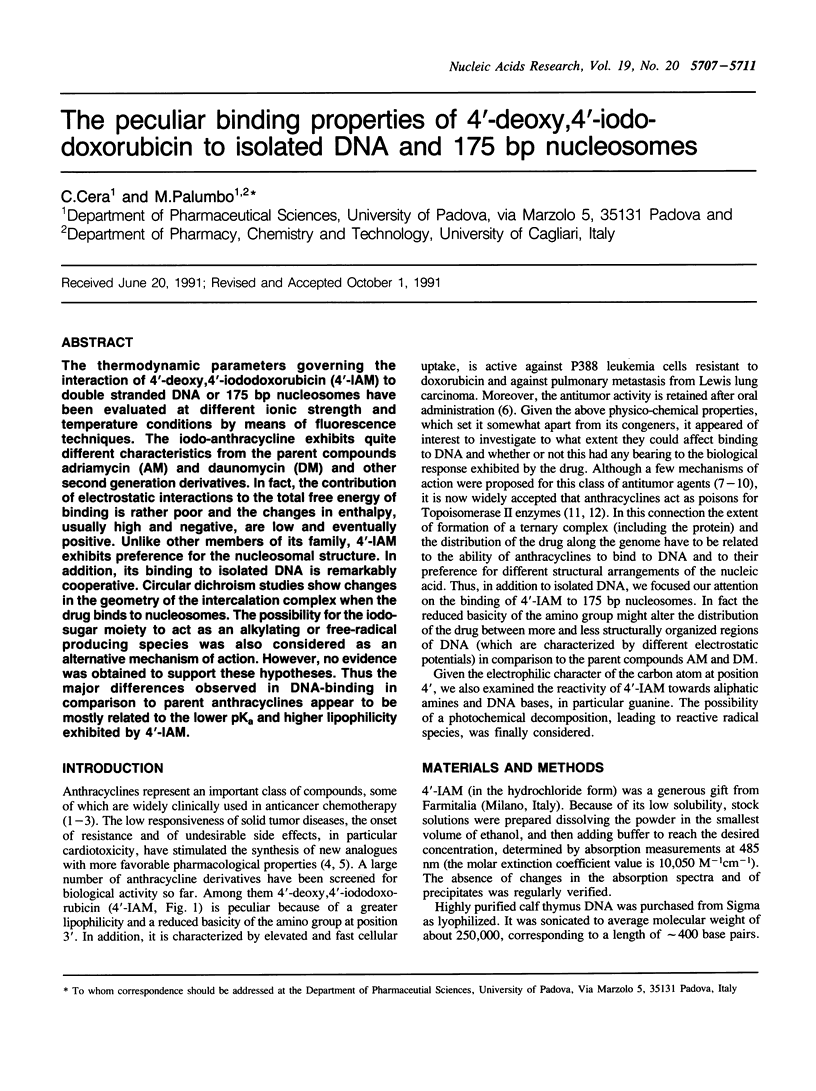
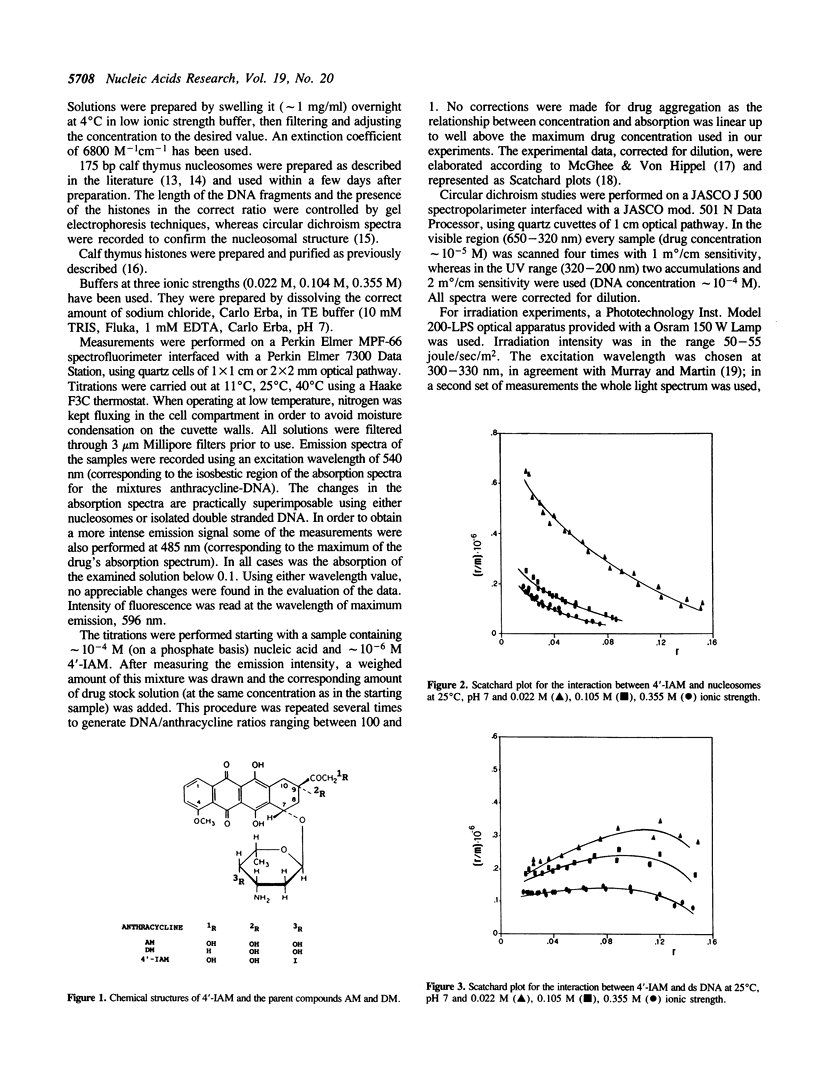
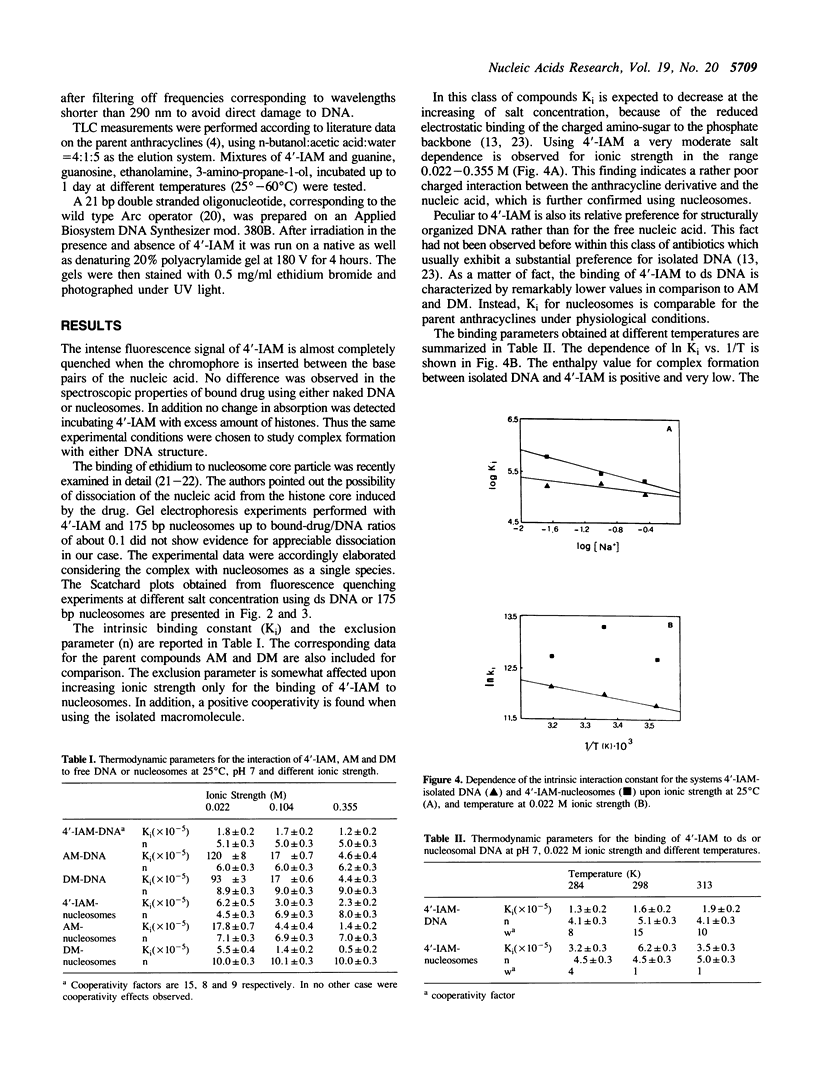
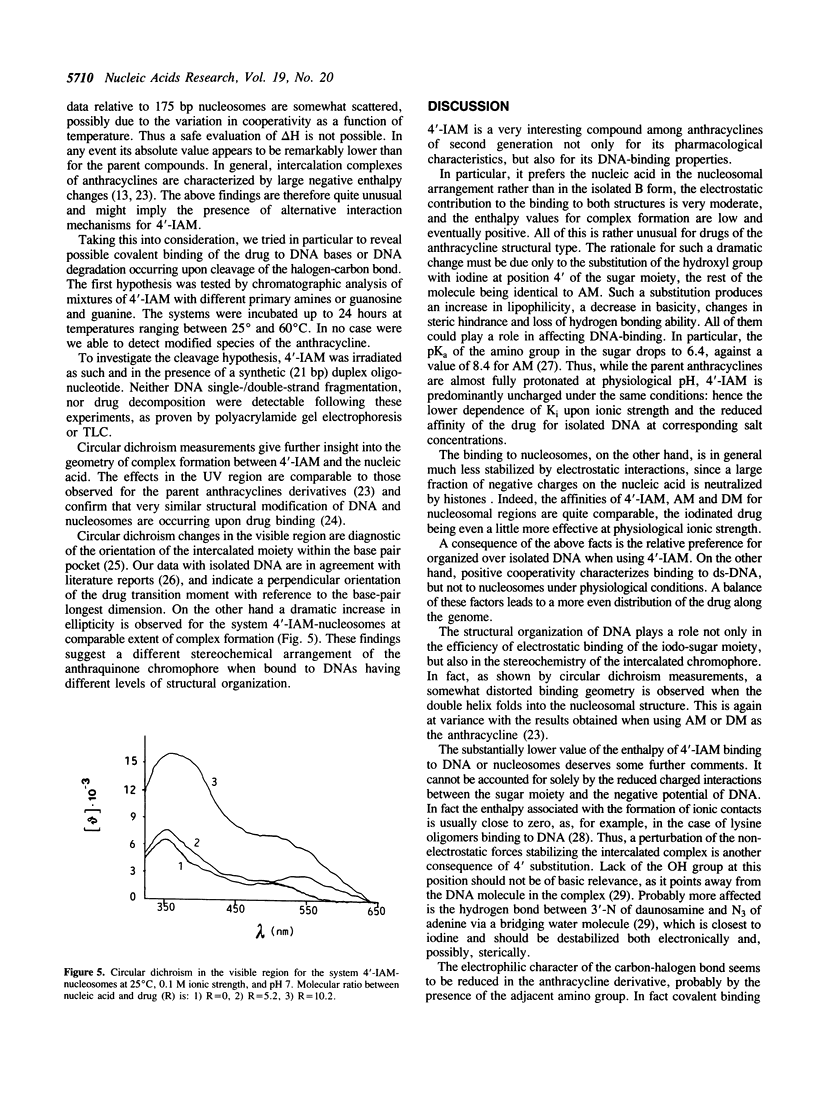
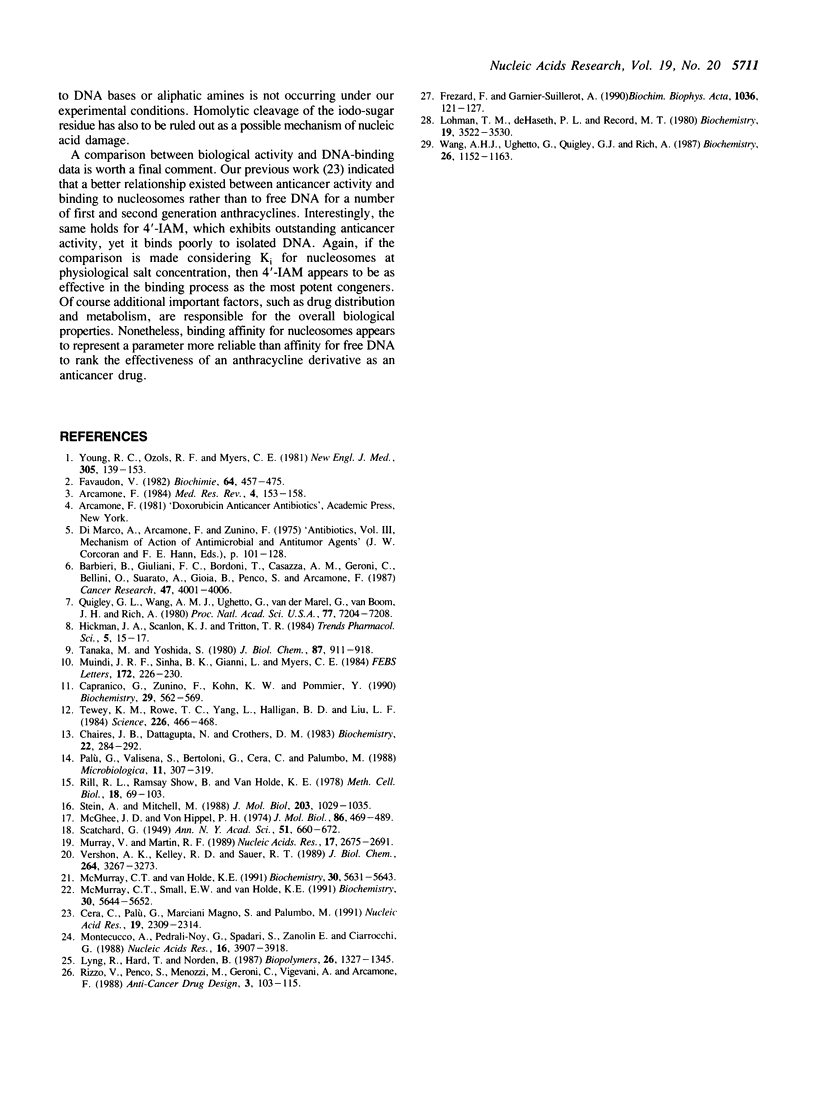
Selected References
These references are in PubMed. This may not be the complete list of references from this article.
- Arcamone F. Antitumor anthracyclines: recent developments. Med Res Rev. 1984 Apr-Jun;4(2):153–188. doi: 10.1002/med.2610040203. [DOI] [PubMed] [Google Scholar]
- Barbieri B., Giuliani F. C., Bordoni T., Casazza A. M., Geroni C., Bellini O., Suarato A., Gioia B., Penco S., Arcamone F. Chemical and biological characterization of 4'-iodo-4'-deoxydoxorubicin. Cancer Res. 1987 Aug 1;47(15):4001–4006. [PubMed] [Google Scholar]
- Capranico G., Zunino F., Kohn K. W., Pommier Y. Sequence-selective topoisomerase II inhibition by anthracycline derivatives in SV40 DNA: relationship with DNA binding affinity and cytotoxicity. Biochemistry. 1990 Jan 16;29(2):562–569. doi: 10.1021/bi00454a033. [DOI] [PubMed] [Google Scholar]
- Cera C., Palù G., Magno S. M., Palumbo M. Interaction between second generation anthracyclines and DNA in the nucleosomal structure. Nucleic Acids Res. 1991 May 11;19(9):2309–2314. doi: 10.1093/nar/19.9.2309. [DOI] [PMC free article] [PubMed] [Google Scholar]
- Chaires J. B., Dattagupta N., Crothers D. M. Binding of daunomycin to calf thymus nucleosomes. Biochemistry. 1983 Jan 18;22(2):284–292. doi: 10.1021/bi00271a009. [DOI] [PubMed] [Google Scholar]
- Favaudon V. On the mechanism of reductive activation in the mode of action of some anticancer drugs. Biochimie. 1982 Jul;64(7):457–475. doi: 10.1016/s0300-9084(82)80162-4. [DOI] [PubMed] [Google Scholar]
- Frezard F., Garnier-Suillerot A. Comparison of the binding of anthracycline derivatives to purified DNA and to cell nuclei. Biochim Biophys Acta. 1990 Nov 9;1036(2):121–127. doi: 10.1016/0304-4165(90)90023-p. [DOI] [PubMed] [Google Scholar]
- Lohman T. M., deHaseth P. L., Record M. T., Jr Pentalysine-deoxyribonucleic acid interactions: a model for the general effects of ion concentrations on the interactions of proteins with nucleic acids. Biochemistry. 1980 Jul 22;19(15):3522–3530. doi: 10.1021/bi00556a017. [DOI] [PubMed] [Google Scholar]
- Lyng R., Härd T., Norden B. Induced CD of DNA intercalators: electric dipole allowed transitions. Biopolymers. 1987 Aug;26(8):1327–1345. doi: 10.1002/bip.360260809. [DOI] [PubMed] [Google Scholar]
- McGhee J. D., von Hippel P. H. Theoretical aspects of DNA-protein interactions: co-operative and non-co-operative binding of large ligands to a one-dimensional homogeneous lattice. J Mol Biol. 1974 Jun 25;86(2):469–489. doi: 10.1016/0022-2836(74)90031-x. [DOI] [PubMed] [Google Scholar]
- McMurray C. T., Small E. W., van Holde K. E. Binding of ethidium to the nucleosome core particle. 2. Internal and external binding modes. Biochemistry. 1991 Jun 11;30(23):5644–5652. doi: 10.1021/bi00237a002. [DOI] [PubMed] [Google Scholar]
- McMurray C. T., van Holde K. E. Binding of ethidium to the nucleosome core particle. 1. Binding and dissociation reactions. Biochemistry. 1991 Jun 11;30(23):5631–5643. doi: 10.1021/bi00237a001. [DOI] [PubMed] [Google Scholar]
- Montecucco A., Pedrali-Noy G., Spadari S., Zanolin E., Ciarrocchi G. DNA unwinding and inhibition of T4 DNA ligase by anthracyclines. Nucleic Acids Res. 1988 May 11;16(9):3907–3918. doi: 10.1093/nar/16.9.3907. [DOI] [PMC free article] [PubMed] [Google Scholar]
- Muindi J. R., Sinha B. K., Gianni L., Myers C. E. Hydroxyl radical production and DNA damage induced by anthracycline-iron complex. FEBS Lett. 1984 Jul 9;172(2):226–230. doi: 10.1016/0014-5793(84)81130-8. [DOI] [PubMed] [Google Scholar]
- Murray V., Martin R. F. The degree of ultraviolet light damage to DNA containing iododeoxyuridine or bromodeoxyuridine is dependent on the DNA sequence. Nucleic Acids Res. 1989 Apr 11;17(7):2675–2691. doi: 10.1093/nar/17.7.2675. [DOI] [PMC free article] [PubMed] [Google Scholar]
- Palù G., Valisena S., Bertoloni G., Cera C., Palumbo M. A further insight into the mechanism of action of anthracycline antibiotics. Microbiologica. 1988 Oct;11(4):307–319. [PubMed] [Google Scholar]
- Quigley G. J., Wang A. H., Ughetto G., van der Marel G., van Boom J. H., Rich A. Molecular structure of an anticancer drug-DNA complex: daunomycin plus d(CpGpTpApCpG). Proc Natl Acad Sci U S A. 1980 Dec;77(12):7204–7208. doi: 10.1073/pnas.77.12.7204. [DOI] [PMC free article] [PubMed] [Google Scholar]
- Rill R. L., Shaw B. R., Van Holde K. E. Isolation and characterization of chromatin subunits. Methods Cell Biol. 1978;18:69–103. doi: 10.1016/s0091-679x(08)60134-x. [DOI] [PubMed] [Google Scholar]
- Rizzo V., Penco S., Menozzi M., Geroni C., Vigevani A., Arcamone F. Studies of anthracycline--DNA complexes by circular dichroism. Anticancer Drug Des. 1988 Aug;3(2):103–115. [PubMed] [Google Scholar]
- Stein A., Mitchell M. Generation of different nucleosome spacing periodicities in vitro. Possible origin of cell type specificity. J Mol Biol. 1988 Oct 20;203(4):1029–1043. doi: 10.1016/0022-2836(88)90127-1. [DOI] [PubMed] [Google Scholar]
- Tanaka M., Yoshida S. Mechanism of the inhibition of calf thymus DNA polymerases alpha and beta by daunomycin and adriamycin. J Biochem. 1980 Mar;87(3):911–918. doi: 10.1093/oxfordjournals.jbchem.a132821. [DOI] [PubMed] [Google Scholar]
- Tewey K. M., Rowe T. C., Yang L., Halligan B. D., Liu L. F. Adriamycin-induced DNA damage mediated by mammalian DNA topoisomerase II. Science. 1984 Oct 26;226(4673):466–468. doi: 10.1126/science.6093249. [DOI] [PubMed] [Google Scholar]
- Vershon A. K., Kelley R. D., Sauer R. T. Sequence-specific binding of arc repressor to DNA. Effects of operator mutations and modifications. J Biol Chem. 1989 Feb 25;264(6):3267–3273. [PubMed] [Google Scholar]
- Wang A. H., Ughetto G., Quigley G. J., Rich A. Interactions between an anthracycline antibiotic and DNA: molecular structure of daunomycin complexed to d(CpGpTpApCpG) at 1.2-A resolution. Biochemistry. 1987 Feb 24;26(4):1152–1163. doi: 10.1021/bi00378a025. [DOI] [PubMed] [Google Scholar]
- Young R. C., Ozols R. F., Myers C. E. The anthracycline antineoplastic drugs. N Engl J Med. 1981 Jul 16;305(3):139–153. doi: 10.1056/NEJM198107163050305. [DOI] [PubMed] [Google Scholar]


